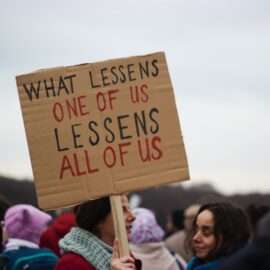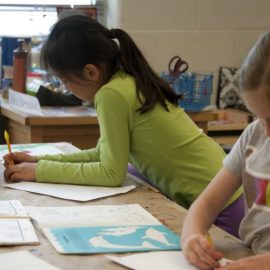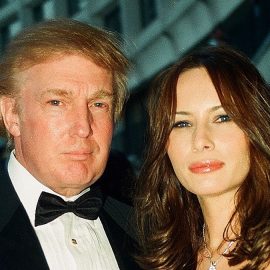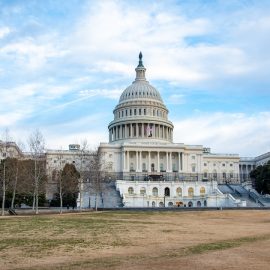
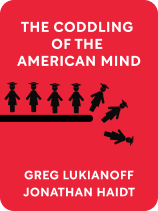
This article is an excerpt from the Shortform book guide to "The Coddling of the American Mind" by Greg Lukianoff and Jonathan Haidt. Shortform has the world's best summaries and analyses of books you should be reading.
Like this article? Sign up for a free trial here .
What are the negative effects of party polarization on college campuses? How are faculty members getting mixed up in campus politics?
In the book The Coddling of the American Mind, the co-authors Jonathan Haidt and Greg Lukianoff discuss the growing divide on college campuses due to American politics. They argue that recent events such as presidential elections are further dividing the country and it is spreading to university students and impacting education.
Continue below to learn about how party polarization is affecting college students.
The Growing Divide in American Politics
Left-wing campus activism is taking place within a climate of rising partisan polarization in America. Political science research shows that there has been a massive divergence on issues between self-identified Democrats and Republicans since the mid-2000s. The Pew Research Center cites a whopping 21-percentage-point disagreement in 2011 between the two parties on basic policy questions—up from just six points in the mid-1990s.
Politically divisive events like the 2003 invasion of Iraq, the 2008 financial crisis, the election of the nation’s first black president, the rise of the Tea Party and Black Lives Matter movements, and the 2016 election of Donald Trump have only amplified the division.
Negative Polarization
The stark ideological differences between the two-party coalitions have dramatically raised the stakes of political competition. Each election cycle becomes a life-or-death struggle between starkly opposed candidates and parties. This has fuelled the growth of what political scientists label “negative polarization”—political mobilization centered not on positive support for one’s preferred party, but hatred and fear of the other party.
We can even see this in the geographic and social landscape of the United States. Americans increasingly live in politically homogenous communities and have fewer and fewer cross-partisan personal relationships. Democrats and Republicans live in worlds that are becoming more and more separate. Thanks to social media platforms like Facebook and Twitter, Americans can easily narrow their news consumption to include only slanted and partisan information that confirms their pre-existing beliefs.
(Shortform note: Want to learn more about the deeper trends driving political party polarization in America? Read our summary of How Democracies Die.)
Anti-University Politics From the Right
Given this rising climate of political mistrust, hostility, and polarization, it’s no wonder college campuses (which have always been strongholds of the left) have become even more strident in their politics.
But this has invited a fierce reaction from the right end of the political spectrum, with right-wing media like Fox News often cynically amplifying and highlighting high-profile incidents of left-wing campus activism. The vicious cycle of action, reaction, and counter-reaction further divides the nation and makes it impossible to engage in any meaningful dialogue across the partisan divide.
Moreover, the actions taken by many on the far right against campus leftists often constitute grave threats to campus safety. Several of the students who participated in the protest at Evergreen State College reported receiving rape and death threats from the right via email and social media. In 2017, a Princeton professor called President Trump a bigot during her commencement remarks at Hampshire College. She was besieged with specific and credible death threats after Fox News publicized her speech.
White Sculptures and White Supremacy
The right targets even those academics who do not make provocative political statements. In 2017, a University of Iowa professor named Sarah Bond published an article in an academic journal in which she discussed Greco-Roman white marble statues. These statues were originally painted in vivid color, but the paint deteriorated over the millennia, leaving us only with the white marble we see today.
Bond argued that the whiteness of these statues contributes to modern-day white supremacist ideas that equate “whiteness” with aesthetic beauty and with humanity’s highest cultural achievements—in no small part because they contribute to the anachronistic belief that ancient Greeks and Romans were “white” (a racial concept that simply did not exist in the classical world).
Right-wing media wilfully misrepresented the content of the paper, claiming that Bond believed that the use of white marble in and of itself was racist and that anyone who enjoyed classical art was therefore a white supremacist. Online right-wing mobs harassed Bond, issued the now all-too-familiar threats of violence, and called for her firing.
A Growing Culture of Hate
University administrations have failed to defend professors from violent online threats made by off-campus right-wing provocateurs—just as they previously failed to stand up for faculty threatened by left-wing militancy on campus.
This further contributes to the chilling effect on free expression, as professors are left with no choice but to self-censor, lest they face withering abuse from either the left or the right. The zone of acceptable discourse continues to narrow from both ends of the political spectrum.

———End of Preview———
Like what you just read? Read the rest of the world's best book summary and analysis of Greg Lukianoff and Jonathan Haidt's "The Coddling of the American Mind" at Shortform .
Here's what you'll find in our full The Coddling of the American Mind summary :
- The "three Untruths" that have taken hold of young people
- The damage that "speech codes" cause on college campuses
- How colleges are increasingly seeing students as customers

